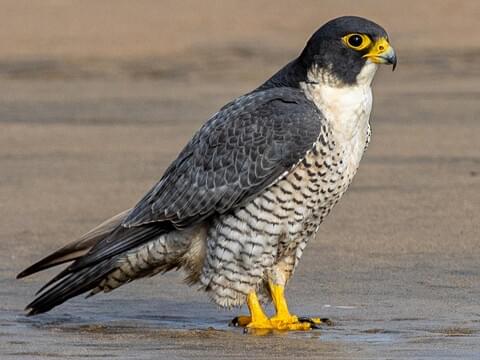Have you ever looked up at the sky and wondered if the bird soaring above you was a hawk, an eagle, or a falcon? These birds of prey are often mistaken for each other due to their similar qualities, but there are several notable differences that distinguish them from one another. Let’s embark on a journey to explore these fascinating birds and discover the Difference Between Hawk, Eagle, and Falcon.
Brief Overview of Difference between Hawk, Eagle and Falcon
Hawks, eagles, and falcons belong to the same family of birds known as Accipitridae, which is a group of diurnal raptors. These birds are renowned for their sharp vision, powerful talons, and hooked beaks, which enable them to catch and eat their prey.
Taxonomy and Classification
When it comes to taxonomy, hawks, eagles, and falcons are classified in the following ways:
Kingdom: Animalia
Phylum: Chordata
Class: Aves
Order: Accipitriformes
Explanation of the Taxonomy of Hawks, Eagles, and Falcons
Within the order Accipitriformes, hawks, eagles, and falcons are further categorized into different families and subfamilies. Hawks, also known as Accipitrinae, are known for their broad wings and long tails, which provide excellent maneuverability during flight.
Eagles, on the other hand, belong to the subfamily Aquilinae and are characterized by their large size and powerful bodies. They are known for their impressive hunting prowess and are often found in open habitats like grasslands and mountainous regions.
Falcons, belonging to the subfamily Falconinae, are renowned for their high-speed aerial pursuits. They have a unique aerodynamic shape, with long, pointed wings allowing them to reach incredible speeds while diving to catch their prey.
Key Differences in their Scientific Classifications
Although hawks, eagles, and falcons belong to the same order and share many similarities, there are some key differences in their scientific classifications. These differences mainly lie in the subfamily they belong to.
Hawks are classified under the subfamily Accipitrinae, eagles fall under Aquilinae, and falcons are categorized in Falconinae. These distinctions are based on various anatomical, ecological, and behavioral characteristics specific to each subfamily.
Summary of Difference between Hawk, Eagle, and Falcon
| Aspect | Hawks | Eagles | Falcons |
|---|---|---|---|
| Taxonomic Classification | Subfamily Accipitrinae | Subfamily Aquilinae | Subfamily Falconinae |
| Size | Medium-sized | Large | Small to medium-sized |
| Body Shape | Broad wings, long tails | Large bodies, long wings | Slender bodies, pointed wings |
| Feather Patterns/Colors | Predominantly brown and gray plumage | Dark feathers with lighter head/tail | Vibrant coloration, range of hues |
| Flight Style | Soaring, gliding, swift direction change | Soaring over open habitats | High-speed aerial pursuits, stoops |
| Preferred Habitat | Forests, woodlands, grasslands, urban areas | Near coasts, rivers, lakes, open habitats | Various habitats including deserts, grasslands, urban areas |
| Geographic Range | Global distribution | Global distribution | Global distribution |
| Behavior | Solitary hunters, territorial | Often social during breeding season | Solitary or social, depending on species |
| Nesting and Breeding | Build nests in trees, cliffs, man-made structures | Build large nests (eyries) in trees or cliffs | Nests on cliffs, buildings, ground |
Common Species Examples for Each Group
Let’s now take a closer look at some common species examples for each group:
Hawks:
Red-tailed Hawk (Buteo jamaicensis) – This widespread hawk species is known for its distinctive brick-red tail and broad wingspan. They can be found in various habitats throughout North America.
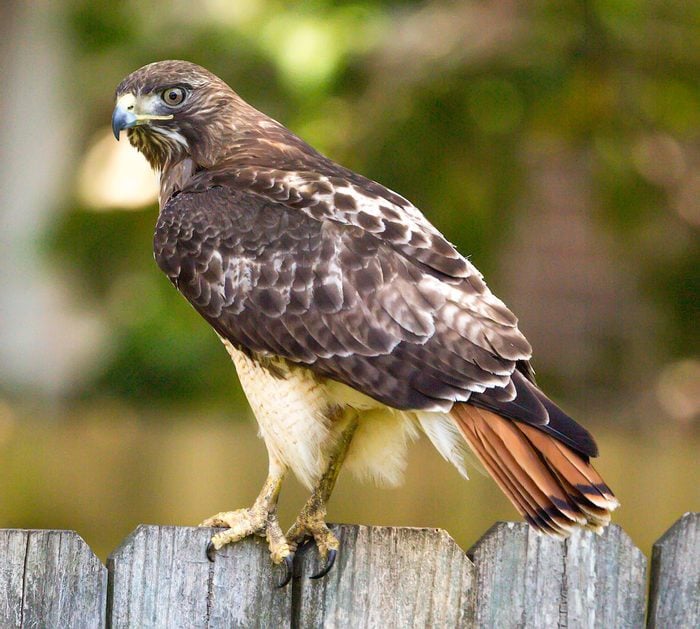
Image-TERRY MOORE
Cooper’s Hawk (Accipiter cooperii) – These agile hawks are notorious for their stealthy hunting techniques in dense woodland areas. They have short, rounded wings that allow them to swiftly navigate through the trees in pursuit of prey.
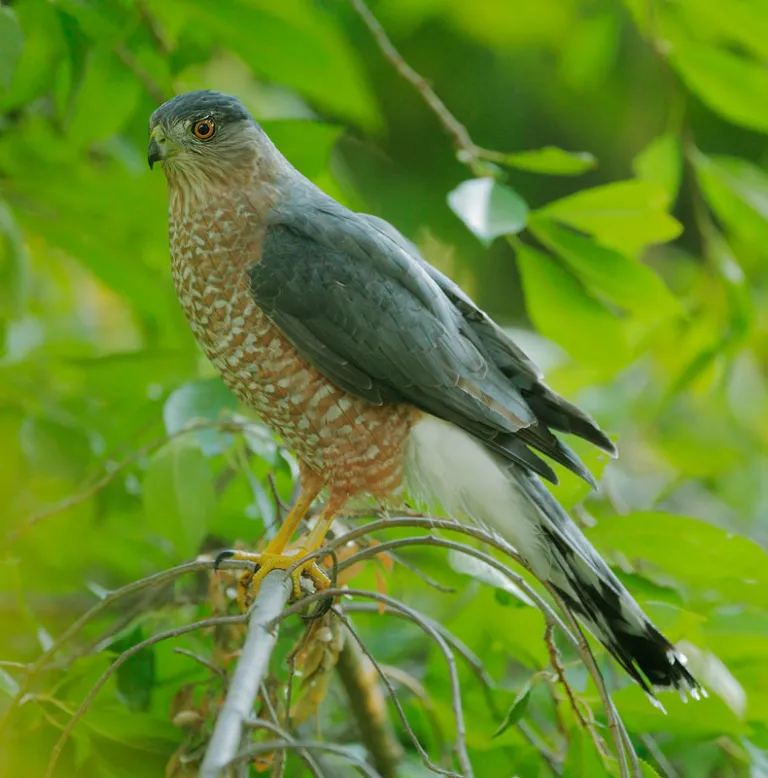
Eagles:
Bald Eagle (Haliaeetus leucocephalus) – The bald eagle, with its iconic white head and tail, is a symbol of power and grace. Found in North America, particularly near large bodies of water, they are revered for their impressive size and soaring abilities.
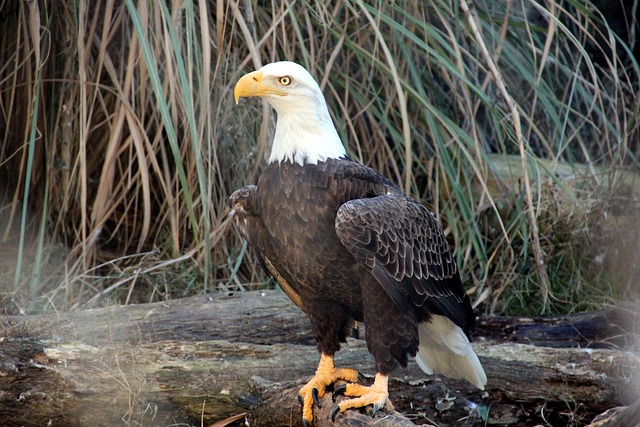
Golden Eagle (Aquila chrysaetos) – This magnificent bird of prey is renowned for its golden-brown plumage and impressive wingspan. They are found in open habitats, including mountains and grasslands, and are known for their hunting skills.
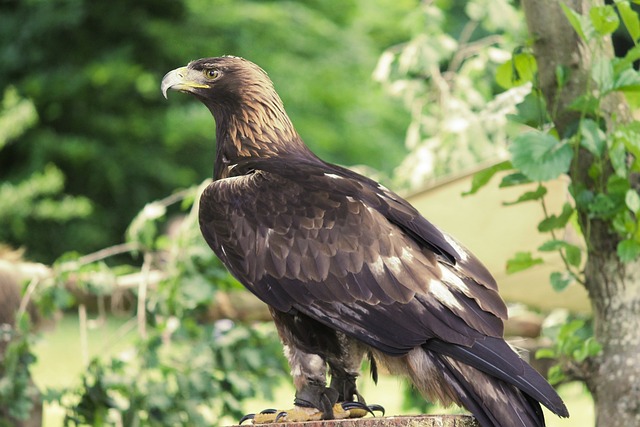
Falcons:
Peregrine Falcon (Falco peregrinus) – Known as the fastest animal on the planet, peregrine falcons are famous for their incredibly swift aerial dives, or stoops, often reaching speeds over 240 miles per hour. They can be found worldwide, from urban skyscrapers to remote cliffs.
American Kestrel (Falco sparverius) – The smallest and most colorful falcon in North America, the American kestrel possesses vibrant feathers and a distinct face pattern. They are often seen hovering in search of small prey, such as insects and rodents, across a range of habitats.
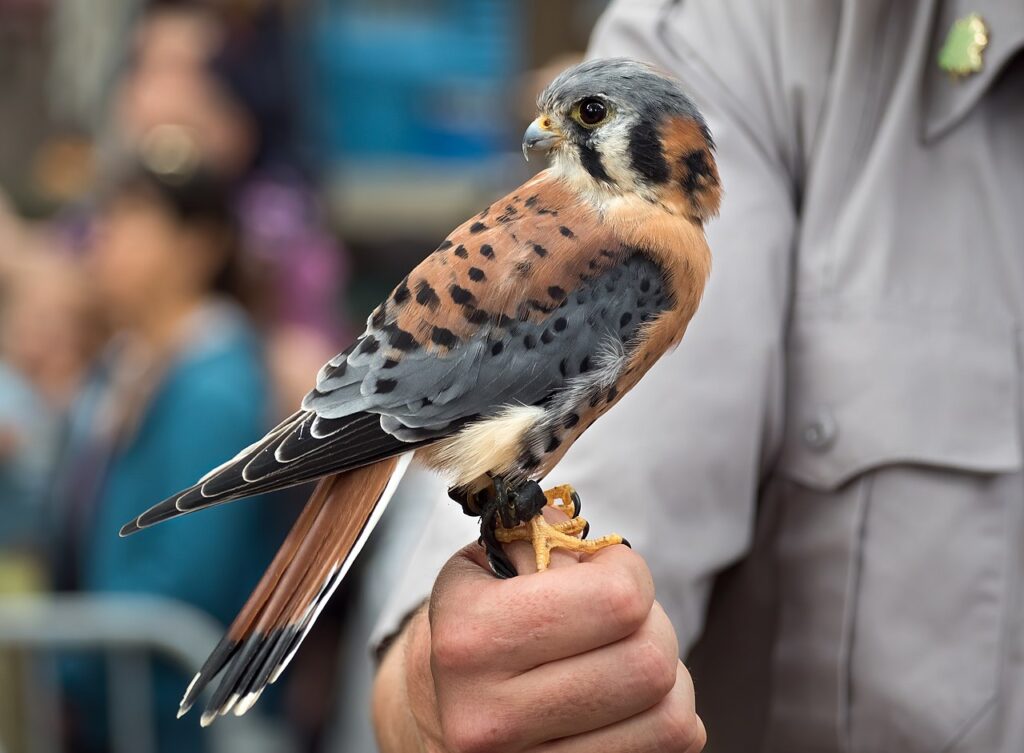
Physical Characteristics
Birds of prey, including hawks, eagles, and falcons, boast a range of physical characteristics that contribute to their impressive prowess in the sky. Let’s dive into some key features that distinguish these majestic birds.
A. Size and Body Shape Differences between hawk, eagle and falcon
Size and body shape vary significantly among hawks, eagles, and falcons, reflecting their diverse ecological roles. Hawks generally have medium-sized bodies and broad wings, facilitating flight maneuverability.
Eagles, on the other hand, exhibit larger body sizes and longer wings, designed for soaring over open habitats.
Falcons, renowned for their exceptional speed, have slender bodies and long, pointed wings, aiding their agility and swift aerial pursuits.
B. Feather Patterns and Colors
Feathers play a vital role not only in flight but also in providing camouflage and attracting mates. Hawks, with their predominantly brown and gray plumage, often possess subtle patterns to blend into their natural surroundings.
Eagles typically have dark feathers with contrasting lighter head and tail feathers, a feature that distinguishes the iconic bald eagle.
Falcons exhibit vibrant coloration, ranging from rich browns and grays to vivid blues and reds, making them striking birds to behold.
C. Beak and Talon Variations
The beaks and talons of hawks, eagles, and falcons are specialized tools for capturing and killing prey. Hawks, with their robust beaks, are designed for tearing flesh and have sharp, curved talons for gripping their victims.
Eagles possess powerful, hooked beaks, enabling them to catch and tear apart larger prey. Their talons are long and formidable, aiding in the capture and transportation of both fish and land-based animals.
Falcons have sharp, notched beaks, perfectly designed for efficiently severing the spinal cords of their prey. Their talons, like those of eagles, are also strong and adapted for catching and restraining prey mid-flight.
D. Wing Structure and Flight Styles
The wings of these birds of prey are essential for their remarkable flight capabilities. Hawks, being versatile hunters, have broad wings that allow them to soar, glide, and swiftly change direction while searching for prey.
Eagles, known for their soaring ability, possess long, broad wings that help them cover vast distances with minimal effort.
Falcons have slender, pointed wings, enabling them to reach incredible speeds during their characteristic high-speed dives known as “stoops.” This wing structure, combined with their aerodynamic bodies, allows them to excel at hunting agile prey in mid-air.
Habitat and Range
Hawks, eagles, and falcons are incredibly adaptable birds, occupying diverse habitats across the globe. While they exhibit some habitat preferences, they can be found in a wide range of environments. Let’s explore their preferred habitats and geographic ranges.
A. Preferred Habitats for Hawks
Hawks are adaptable hunters, and their preferred habitats vary depending on their specific ecological needs. Generally, hawks are found in a range of environments such as forests, woodlands, grasslands, and even urban areas. Some species, like the Red-tailed Hawk, thrive in open habitats and agricultural areas where they can spot their prey from elevated perches. Others, like the Cooper’s Hawk, are skilled at maneuvering through dense forests to surprise their prey.
B. Typical Environments Where Eagles Thrive
Eagles are known for their association with watery environments, and many species are found near coasts, rivers, lakes, and other bodies of water. They typically prefer open habitats and are often associated with areas abundant in fish, which form a significant part of their diet. Eagles, such as the Bald Eagle and the White-bellied Sea Eagle, are known for their ability to soar and hunt over expansive waterways.
C. Falcon’s Habitat Preferences
Falcons display unique habitat preferences, primarily dictated by their high-speed hunting tactics. They are adaptable birds and can be found across various habitats, including deserts, grasslands, coastal areas, and even urban environments. Many falcon species, like the Peregrine Falcon, nest on cliffs and feed on open-skies prey. Others, like the American Kestrel, are skilled at hunting in open fields and hovering in the air to spot their prey.
D. Geographic Ranges of These Birds
Hawks, eagles, and falcons exhibit a wide geographic distribution, occupying different regions around the world. Hawks, for instance, can be found in North America, South America, Europe, Africa, Asia, and Australia. They are incredibly diverse and have adapted to a variety of climates and habitats across their ranges.
Eagles have a widespread distribution as well. Species like the Bald Eagle are found exclusively in North America, while others, like the Golden Eagle or the African Fish Eagle, have a broader range that spans across continents.
Falcons also have a global distribution, with various species occupying different regions. The Peregrine Falcon, for example, has a worldwide distribution, being found on every continent except Antarctica. The American Kestrel is native to North and South America.
Behavior and Social Structure
Birds of prey, including hawks, eagles, and falcons, exhibit diverse behavioral patterns and social structures. Let’s explore their tendencies toward solitariness or sociality, their nesting and breeding behaviors, as well as their territorial instincts.
A. Solitary vs. Social Tendencies
The behavior of raptors can vary when it comes to their tendencies toward solitude or social interaction. Generally, hawks tend to be more solitary birds, often seen hunting and foraging alone. They have individual territories and prefer to claim a hunting ground for themselves. However, during migration, hawks may gather in large numbers at specific locations, providing opportunities for social interaction and communal roosting.
Eagles, on the other hand, typically exhibit social behavior, especially during the breeding season. They often form monogamous pairs that work together to build nests, hunt for food, and raise their young. Bald Eagles, for example, often return to the same nesting site year after year and form strong bonds with their mates.
Falcons exhibit a mix of solitary and social tendencies. Some falcons, like the peregrine falcon, often breed and live in solitary pairs. They maintain exclusive territories and hunt independently. However, during migration, falcons may form flocks, allowing for social interactions and communal roosting.
B. Nesting and Breeding Behaviors
The nesting and breeding behaviors of hawks, eagles, and falcons vary based on their species. Generally, these raptors are monogamous, meaning they mate with only one partner during a breeding season. They often engage in elaborate courtship displays, such as aerial displays and vocalizations, to attract and bond with their mates.
Hawks build nests in trees, cliffs, or even on man-made structures like buildings or utility poles. They construct large nests made of twigs and line them with softer materials like leaves or bark. These nests are sometimes used for multiple years if they remain intact and unoccupied.
Eagles build large nests called eyries high in trees or on cliffs. These nests are constructed with large sticks and are continually added to and expanded year after year. Bald eagles are known for their impressive nest structures, which can reach several meters in diameter.
Falcons, depending on the species, may nest on cliffs, buildings, or even on the ground. Their nests, called scrapes, are shallow depressions, often lined with small twigs, leaves, and feathers. Falcons do not build elaborate structures like hawks or eagles.
Conservation Status
Raptors, including hawks, eagles, and falcons, have faced significant threats to their survival, leading to declines in population numbers in some cases. In response, conservation efforts have been implemented globally to help protect these magnificent birds of prey.
Threats to these Birds of Prey
There are several threats to raptors, including habitat destruction, pollution, hunting, and climate change. Loss of habitat can force raptors to relocate or adjust to new and sometimes unsuitable environments. Pollution, including pesticides and heavy metals, can accumulate in raptors’ prey and impact their health and reproduction.
Hunting and intentional killing of raptors, often due to misconceptions about their impact on other wildlife or livestock, also pose a threat to these birds of prey. Climate change can also impact raptors, affecting prey availability and distributions, altering habitats, and reducing breeding success.
Populations Trends and Statuses for Different Species
The populations of raptor species are constantly monitored to evaluate their conservation statuses. Some species that were once declining have shown considerable population growth due to conservation efforts. For example, the Bald Eagle, once an endangered species in the United States, has shown a significant population increase, with numbers now estimated to be in the hundreds of thousands.
In contrast, other species, such as the Philippine Eagle and the African Crowned Eagle, remain critically endangered due to ongoing threats. Species like the California Condor and Mauritius Kestrel have managed to bounce back from the brink of extinction, thanks to successful captive breeding programs and release initiatives.


